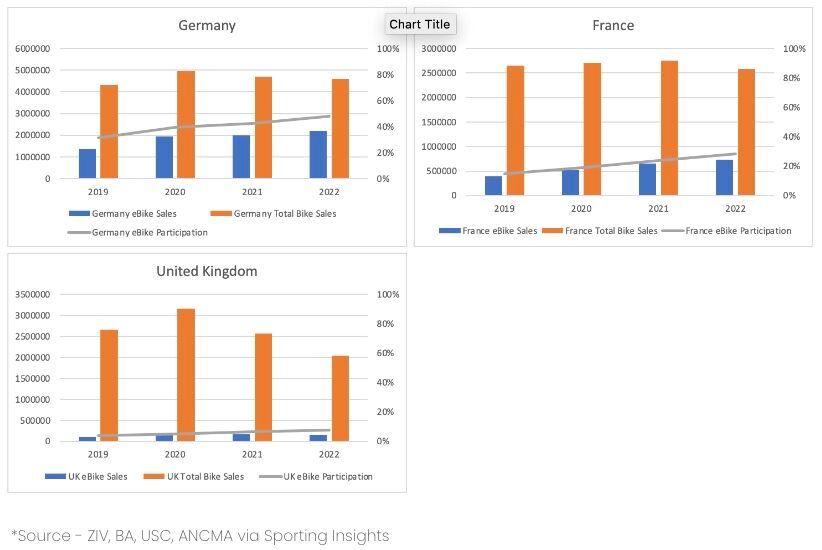Lee Kidger, February 2024
Recently, I was invited to speak at the All Party Parliamentary Group meeting for Walking & Cycling in Westminster.
The brief was clear – to highlight where our European counterparts have benefited from fiscal stimulation within the electric bike subsidy space to highlight the potential for the United Kingdom. Why is this important? Because there is enormous potential for this to be something that kickstarts new growth across our billion pound cycling industry.
In the EU, there are already over 300 financial schemes in the EU that assist people buying electric bicycles and cargo bikes. These schemes provide a range of direct and indirect financial support, with the amounts offered ranging from €800 to €2,500 and various types of electric bikes and electric cargo bikes eligible for purchase. Some schemes target people with specific transit needs, whether individuals or businesses. Others, like France’s Upway, are means tested to provide enhanced mobility to low-income families. Some support second-hand sales to double down on the sustainability benefits of active travel.
With the cycling industry feeling the pinch in the UK – as attested by the Bicycle Association Market Data Service (MDS), powered by Sporting Insights – more and better communicated subsidies could be the tonic that UK cycling manufacturers and retailers need to return to growth.
Time and again research finds, in all different spheres, an appetite among consumers to be more sustainable in how they work and play. A lack of money and information though stands in the way of intention becoming action all too often. This comes through in cycling research, but the industry is far from alone here. Recent running research by Sporting Insights for example found an intention gap among runners, many of whom wanted to take more proactive steps to be more sustainable but felt like they lacked the opportunities to do so. 2019 analysis by the Bicycle Association suggested that a grant for the purchase of electric bicycles could be extremely cost-effective in cutting CO2 emissions by increasing active travel.
While it’s clear that there is no one size fits all approach – subsidies in France are targeted and administered differently to those in Germany, which are different to those in the Netherlands, which are different to, well, you get the point – European schemes do tend to offer a deeper, more direct, and ultimately more decisive amount of financial support than the schemes that have so far been tried in the UK.
To date, the UK government has been reluctant to offer as much direct financial support for long-term electric bike ownership. We have seen schemes from the Energy Saving Trust, but these have always been more interest free loans, rather than fiscal subsidies for the purchasers. A good start, but we must be able to do more. The government also ran a 2022 pilot in Greater Manchester that allowed people to try electric bikes over short-term and long-term periods. But while these kinds of schemes might change attitudes and create aspirations of owning an electric bike, they do little to make electric bikes more affordable.
Electric bikes are available through the Cycle to Work scheme – It’s a fantastic scheme for getting people on bikes, however, does have its limitations. Terminology also plays an extremely important part in consumer understanding. The UK lacks clarity on how we communicate our purchase scheme, which leads to varying knowledge levels and lower take up than our European peers.

The above graph clearly shows the potential where a clear fiscal stimulation, whatever form that can be, can work. The adoption levels of electric bicycles in Germany & France is growing rapidly, which can be linked to their governments’ tactical approach to greener, more sustainable travel. In France, Sporting Insights research shows that almost a quarter of e-bike buyers in the last twelve months used the subsidy scheme. The UK however, which started from a similar electric bike sales base in 2016, has witnessed substantially more sluggish uptake in electric bike ownership during the same period.
Incentives are only part of the solution. To be most effective, subsidies need to take their place alongside dedicated infrastructure development and the restriction of car traffic within certain urban areas. To gauge the impact of such schemes, just look at Paris, where visitors to this year’s Olympic Games will see, as they walk or ride down the banks of the Seine – now part of over 1,000km of bike lanes – a city centre transformed by Anne Hidalgo’s ‘100% bikeable Paris’ plan. In early September 2023, counting programmes on a cycle path of Sebastopol Boulevard registered more than 124,000 riders, and the authorities plan on making all the venues for the games reachable by bike by residents and tourists alike.
The evidence is no longer in question. Across Europe, research shows, through all sorts of methodologies and all sorts of metrics, that the existence of a clear strategic plan tailored to how a country earns, moves, and exercises, can lead to heightened adoption of electric bikes. In the UK, we must do more to follow through on our promises and make the most of this promising growth area. We are a decade behind, but to paraphrase the old proverb, if the best time for an electric bike subsidy scheme was ten years ago, the second best time is now.
Lee Kidger is Sporting Insights’ special advisor for mobility and active transport. Find out more about Lee here.


